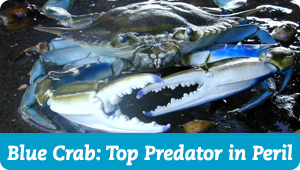Zones of low oxygen in the water—often called dead zones—can hurt the growth, reproduction and survival of fish and other animals. They can alter food webs in our estuaries and coastal oceans. Low oxygen is a serious consequence of humans discharging nitrogen and phosphorus into our waterways through sewage, agriculture and industry.

Daily cycles of oxygen (blue) and pH (red) in Bear Creek, Md. During the day, photosynthesis keeps O2 high. But when it stops at night, O2 drops and CO2 rises, making the water more acidic (lower pH). (MD Department of Natural Resources)
Oxygen levels in shallow waters swing wildly from day to night. Ecologists like Denise Breitburg call it diel-cycling hypoxia. During the day, plants release plenty of oxygen into the water through photosynthesis. When the sun disappears at night, plants and animals continue to respire and draw oxygen out of the water. But without photosynthesis to replenish it, oxygen levels plummet.
Day-night cycles have always occurred naturally. But nutrient pollution from land—a more recent problem—has stretched them to extremes. Excess nitrogen and phosphorus create blooms of microscopic algae, or phytoplankton. When these phytoplankton respire, they pull even more oxygen out of the water, creating the wild fluctuations in coastal waters today.
But if these “dead zones” last only a few hours, how deadly can they be? Breitburg’s lab is uncovering their true impact by looking at one of Chesapeake Bay’s most beloved creatures: the eastern oyster, Crassostrea virginica.

Slides of oysters suffering different intensities of Dermo as the Perkinsus parasite multiplies, from healthy (left) to severe (right).
Oysters in these zones don’t usually die from lack of oxygen. Instead, they become more vulnerable to a deadly parasite, Perkinsus marinus. Perkinsus marinus causes Dermo, one of two major diseases to cripple oyster populations in Chesapeake Bay in recent decades. Once inside the oyster, the parasite multiplies until hundreds of thousands of them literally take over the oyster’s body. At first, oysters suffer slower growth, diminished reproduction and a weakened ability to filter the water. Eventually they die.
Breitburg and her research crew have discovered that low oxygen cycles are spurring the parasite along. In lab experiments, uninfected oysters exposed to even just a few hours of low oxygen at night had more than twice the infection rate of oysters in healthier waters.
Disease is hardly the only threat to the eastern oyster. Overfishing and habitat loss have played the most important roles in shrinking the Chesapeake’s oyster population. But the Perkinsus parasite is making a comeback more difficult. The good news: Oysters could play a role in their own recovery. Because of their ability to filter water, oysters could help clean shallow areas in the Bay for themselves and for other life in the Chesapeake. Right now their numbers are too few. But if enough oysters were restored in shallow waters, they may help stabilize the nightly oxygen drops that are plaguing them today.
Learn more!
Find out more on Denise Breitburg’s research in the Marine and Estuarine Ecology Lab.


 Calculate your
Calculate your 

